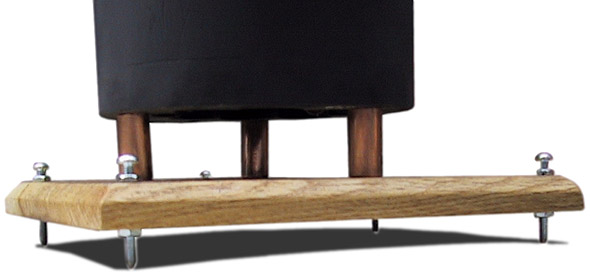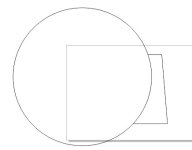You may have trouble finding enuff room on the base of the prism to fit the driver. On secound look maybe not.
You need to ensure that the feet hold the driver sufficiently far from the floor, and unless it is hardwood or stone you should add a reflecting base. Like the distance from the wall, the floor can provide mass-loading to the front side of the driver.

dave
You need to ensure that the feet hold the driver sufficiently far from the floor, and unless it is hardwood or stone you should add a reflecting base. Like the distance from the wall, the floor can provide mass-loading to the front side of the driver.

dave
Hello,
I was trying to draw the FH MK3 in Corel draw.
My reference is page no: 4 of the document: http://www.frugal-horn.com/downloads/frugel-hornMk3-1v0-060518.pdf.
My result is attached here, but it looks different from the drawing given in the build plan.
The curve has a radius of 1775mm, but it looks very different.
The front baffle is 85 degrees inclined to the left.
Request guidance on drawing the curved portion in Corel Draw
Thank you!
Sumesh
I was trying to draw the FH MK3 in Corel draw.
My reference is page no: 4 of the document: http://www.frugal-horn.com/downloads/frugel-hornMk3-1v0-060518.pdf.
My result is attached here, but it looks different from the drawing given in the build plan.
The curve has a radius of 1775mm, but it looks very different.
The front baffle is 85 degrees inclined to the left.
Request guidance on drawing the curved portion in Corel Draw
Thank you!
Sumesh
Attachments
Hi! Not sure about Corel Draw (or the dia/rad issue), but I have found the wiki.geogebra.org site to be helpful. It takes a bit to figure out the interface, but once I did, it beats me trying to do this in Excel or PowerPoint (I could probably do it by hand if I had all my draftsman tools, but that was 30+ years ago now).... Corel draw. ...
I need to go, so these aren't the exact tools, they are just the ones that I had sent to someone else a while ago.
https://wiki.geogebra.org/en/Circle_through_3_Points_Tool
https://wiki.geogebra.org/en/PerpendicularBisector_Command
Yes you are correct, I made a mistake and took the radius instead of dia. Now the drawing has taken the right shape. Thank you.It seems you draw a circle with the DIAMETER of 1775 mm, not the RADIUS:
The cabinet is 888 mm tall, the circle should be more than 4 times bigger, but seems just twice as big.
Thank you for directing to a powerful platform.Hi! Not sure about Corel Draw (or the dia/rad issue), but I have found the wiki.geogebra.org site to be helpful. It takes a bit to figure out the interface, but once I did, it beats me trying to do this in Excel or PowerPoint (I could probably do it by hand if I had all my draftsman tools, but that was 30+ years ago now).
I need to go, so these aren't the exact tools, they are just the ones that I had sent to someone else a while ago.
https://wiki.geogebra.org/en/Circle_through_3_Points_Tool
https://wiki.geogebra.org/en/PerpendicularBisector_Command
Let me explore.
The frequency is a -3dB nominal but (and it's a significant one) that does not necessarily mean you are -3dB down at that point. You would be if the driver was tracking a flat-line, but that is not always (rarely, in fact) the case. This is accounted for, which is why within the context of what they are, you don't find many people complaining about the LF on any of the FH series.  The only time it can be a mite weak in relative terms with the 'intended' drivers is with the older 126 series units, especially when used with voltage source amplifiers, but these were always meant as a side-option only.
The only time it can be a mite weak in relative terms with the 'intended' drivers is with the older 126 series units, especially when used with voltage source amplifiers, but these were always meant as a side-option only.
If I understand correctly, the horn is designed to counteract the baffle step, and the fibers below the speaker have to be set in a way that the speaker impedance raises enough to give some more lows depending on the DF of the amp it is connected to: flatter for very low DF amps, a bit more as the DF increases to get the same amount of bass.
A low DF amp helps also to increase highs where speaker impedance increases.
It is more or less how it works?
A low DF amp helps also to increase highs where speaker impedance increases.
It is more or less how it works?
Not exactly, you'd need a ~18 1/4in wide baffle to push the step frequency down low enough to match into a reasonable upper corner frequency for a typical bass horn (without GD starting to be problematic). And damping in essence damps, rather than increases. It's only there to control output and help suppress some unwanted shorter wavelengths from passing through the horn, though the internal low-pass choke does a reasonable job of that.
Basically you need to keep in mind that the usual mathematical derivation (4560 / baffle width in inches for a -3dB nominal) is just that: a mathematical derivation. Which is great, but it's only ever an approximation, since we're not working with a flat baseline response. You've got gain at & immediately above / below the ~ 1.4KHz region for a baffle this size on & for a good few degrees off-axis, plus the actual response trend of the driver. Most MA units for example (they're not alone in this, although it's not all that common) have a rising LF response trend below roughly 800Hz depending on model down to the mass-corner frequency. These trendings both tend to cancel out the losses. On top of that -step loss isn't quite so simple as a practical proposition, since (and I'm far from being alone in pointing this out) it's not as if the energy actually vanishes -you'd need extremely lossy room construction for that, and these are boundary loaded designs where you tend to have fewer losses anyway.
Basically you need to keep in mind that the usual mathematical derivation (4560 / baffle width in inches for a -3dB nominal) is just that: a mathematical derivation. Which is great, but it's only ever an approximation, since we're not working with a flat baseline response. You've got gain at & immediately above / below the ~ 1.4KHz region for a baffle this size on & for a good few degrees off-axis, plus the actual response trend of the driver. Most MA units for example (they're not alone in this, although it's not all that common) have a rising LF response trend below roughly 800Hz depending on model down to the mass-corner frequency. These trendings both tend to cancel out the losses. On top of that -step loss isn't quite so simple as a practical proposition, since (and I'm far from being alone in pointing this out) it's not as if the energy actually vanishes -you'd need extremely lossy room construction for that, and these are boundary loaded designs where you tend to have fewer losses anyway.
Hello
I made a pair of Mk3s after finding the drawings in 2010 I used to some Blue Tack to hold one side on each while I tested and stuffed them. I have a pair of CHP70s in them. The bass was so strong the floor, shuttering plywood on a sub floor in a little room at the back of the garage, rattled, I bought some spikes and that stopped the rattle.
I've never felt the urge to make any other speakers ever since, Reely Grate!
Cheers
I made a pair of Mk3s after finding the drawings in 2010 I used to some Blue Tack to hold one side on each while I tested and stuffed them. I have a pair of CHP70s in them. The bass was so strong the floor, shuttering plywood on a sub floor in a little room at the back of the garage, rattled, I bought some spikes and that stopped the rattle.
I've never felt the urge to make any other speakers ever since, Reely Grate!
Cheers
Last edited by a moderator:
- Home
- Loudspeakers
- Full Range
- Frugel-Horn Mk3 Builds & Build Questions
